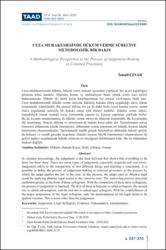| dc.contributor.author | Çınar, İsmail | |
| dc.date.accessioned | 2024-04-04T15:55:35Z | |
| dc.date.available | 2024-04-04T15:55:35Z | |
| dc.date.issued | 2023 | en_US |
| dc.identifier.citation | Çınar, İ. (2023). Ceza muhakemesinde hüküm verme sürecine metodolojik bir bakış. Türkiye Adalet Akademisi Dergisi, 14 (56), 337-370. | en_US |
| dc.identifier.issn | 1309-6826 | |
| dc.identifier.uri | https://hdl.handle.net/20.500.12846/1017 | |
| dc.description.abstract | Ceza muhakemesinde hüküm, hükmü veren makam açısından yapılacak her şeyin yapıldığını
gösteren nihai karardır. Hükmün beraat ve mahkûmiyet başta olmak üzere bazı türleri
bulunmaktadır. Hüküm iki farklı şeyin karşılaştırılarak bir sonuca varılmasını ifade eder.
Ceza muhakemesinde hüküm verme sürecini hâkimin hukuku olaya uyguladığı süreç olarak
tanımlamak mümkündür. Bu süreçte hâkim, bir ya da daha fazla soyut kanuni normu somut
olaya uygulamak suretiyle bir hukuki sonuç elde etmeyi hedefler. Hüküm verme süreci,
metodolojik olarak mantıki kıyas formatında yapılan üç kıyasın yapılması şeklinde ilerler.
Bu üç kıyasın tamamlanması ile hüküm verme süreci de nihayete ermektedir. Bu kıyaslardan
ilki tasımlama, ikincisi altlama ve sonuncusu da hukuki kıyas adını alır. Tasımlamanın sonuç
önermesi altlamanın küçük önermesini, altlamanın sonuç önermesi ise hukuki kıyasın küçük
önermesini oluşturmaktadır. Tasımlamada maddi gerçek bulunurken altlamada hukuki gerçek
de bulunur ve maddi gerçeğe uygulanır. Hukuki kıyasın büyük önermesinin oluşturulması ile
geriye sadece uygulanacak hukuki sonucun ne olacağının belirlenmesi kalır. Bu ise hükümden
başkası değildir. | en_US |
| dc.description.abstract | In criminal proceedings, the judgement is the final decision that shows that everything to be
done has been done. There are some types of judgement, especially acquittal and conviction.
Judgement refers to the comparison of two different things and reaching a conclusion. It is
possible to define the process of judgement-making in criminal procedure as the process by
which the judge applies the law to the case. In this process, the judge aims to obtain a legal
result by applying abstract legal norms to the concrete case. The sentencing process proceeds
methodologically in the form of three syllogisms. With the completion of these three syllogisms,
the process of judgement is finalised. The first of these syllogisms is called syllogism, the second
one is called subsumption, and the last one is called legal syllogism. With the establishment of
the major proposition of the legal syllogism, only the determination of the legal result to be
applied remains. This is none other than the judgement. | en_US |
| dc.language.iso | tur | en_US |
| dc.relation.isversionof | 10.54049/taad.1374340 | en_US |
| dc.rights | info:eu-repo/semantics/openAccess | en_US |
| dc.subject | Hüküm | en_US |
| dc.subject | Hukuki kıyas | en_US |
| dc.subject | Delil | en_US |
| dc.subject | Altlama | en_US |
| dc.subject | Yorum | en_US |
| dc.subject | Judgement | en_US |
| dc.subject | Legal syllogism | en_US |
| dc.subject | Evidence | en_US |
| dc.subject | Subsumption | en_US |
| dc.subject | Interpretation | en_US |
| dc.title | Ceza muhakemesinde hüküm verme sürecine metodolojik bir bakış | en_US |
| dc.title.alternative | A methodological perspective to the process of judgement-making in criminal procedure | en_US |
| dc.type | article | en_US |
| dc.relation.journal | Türkiye Adalet Akademisi Dergisi | en_US |
| dc.identifier.volume | 14 | en_US |
| dc.identifier.issue | 56 | en_US |
| dc.relation.publicationcategory | Makale - Ulusal Hakemli Dergi - Kurum Öğretim Elemanı | en_US |
| dc.contributor.department | TAÜ, Sosyal Bilimler Enstitüsü, Kamu Hukuku Ana Bilim Dalı Koleksiyonu | en_US |
| dc.identifier.startpage | 337 | en_US |
| dc.identifier.endpage | 370 | en_US |

















